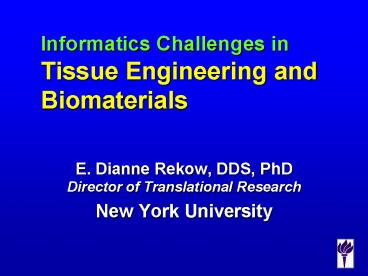Informatics Challenges in Tissue Engineering and Biomaterials
1 / 48
Title: Informatics Challenges in Tissue Engineering and Biomaterials
1
Informatics Challenges in Tissue Engineering and
Biomaterials
- E. Dianne Rekow, DDS, PhDDirector of
Translational Research - New York University
2
The Question
- What is the time-dependent biochemical and
cellular cascade that occurs as a function of - Implant Material
- Surface Texture
- Microporosity
- Pore size, density, connectivity
- 3D dimensional configuration
3
In Vivo Laser-Lok Studies
Bone orientation follows orientation of surface
grooves
4
Microgrooved Surfaces
Inhibit fibroblasts 6-10 µm wide gt2 µm
deep 12-24 µm repeat
Microgrooved surface
5
Tissue Response to 12µm and 8µm Laser Machined
Collar
Laser-Lok
6
Traditional Scaffolds
J. Kohn
7
TheriFormTM 3DP Fabrication Process
8
With Solid Freeform Fabrication Control pore
size, distribution, interconnectivity
9
Controlled surface chemistry (nanostructure)
surface texture (microstructure)
microarchitecture (mesostructure) design
(macrostructure)
8 mm
10
Tissue Response
pDTEC - channels
PLGA- channels
pDTEC waffles solid walls
pDTEC waffles porous walls
10X
11
ERB Designs
Blind channels
Alternating rows of rods
12
MicroCT and 3D Reconstruction
Elizabeth Meyers, PhD Hospital for Special Surgery
13
(No Transcript)
14
(No Transcript)
15
(No Transcript)
16
(No Transcript)
17
(No Transcript)
18
(No Transcript)
19
Back
20
Robo Casting
Jennifer Lewis, UI
21
Does meso-geometry influence tissue response to
bone-fill scaffolds?
22
NJ Scaffolds
23
Optimal pore size
Neovascularization 5 µm Fibroblast ingrowth
5-15 µm Skin 20-125 µm Osteoid - 40-100
µm Bone 130 350 µm BUT!!!
24
Solid HA
Stacked Layers
Staggered Layers
Pore size 15-40 µm
25
Coronal Section
Solid HA
12 weeks
Horizontal Sections
26
Solid HA 200X
27
Scaffold
- Stimulate osteoblast
- migration and
- osteoconduction
- Supports cells and tissues
- Permits diffusion of cells and nutrients
- Provides waste clearance
- Material, surface, plus pore size and
- pore organization influence
- tissue response
28
Javelin Engineering
29
Scaffold materials and features influence implant
tissue interface
30
The Question
- What is the time-dependent biochemical and
cellular cascade that occurs as a function of - Implant Material
- Surface Texture
- Microporosity
- Pore size, density, connectivity
- 3D dimensional configuration
31
(No Transcript)
32
What experiments - or experimental design - do
we need to facilitate that solution?
33
Biomaterials
- Where along the spectrum of flat polished
materials to 10-year clinical in-vivo study
accurately predicts clinical performance?
34
(No Transcript)
35
Model ceramic/polycarbonate bilayers
CHAI H, LAWN B, WUTTIPHAN S (1999) Fracture
modes in brittle coatings with large interlayer
modulus mismatch, J Mater Res 143805-3817.
36
Radial fracture in alumina/polycarbonate
d 150 µm, r 3.96 mm
Young-Woo Rhee
37
Fundamental Relationships for Failure modes (flat
surfaces)
- For cone cracking
- PC A(T2/E)r E elastic modulus
- For yield T toughness
- PY DH(H/E)2r2 H hardness
- For radial cracking sT biaxial tensile
- PR BsTd2/log(Ec/Es) strength
38
(No Transcript)
39
Influence of Damage Glass/Sapphire/Carbonate
Trilayer
40
Influence of cement and tooth core properties
Cement
41
DEFORMATION DURING CYCLIC LOADING
P 20-120N
Cement
Cement substrate
42
VISCOELASTICITY MODEL
43
HYDRAULIC FRACTURE TEST Penetration in to crack
can propagate a crack
p
oil
?c/a
44
Effects of surface finish and fatigue testing
on the fracture strength of CAD-CAM and pressed
ceramic crowns, J Prosthet Dent 82468-475. Chen
HY, et al (1999)
45
(No Transcript)
46
(No Transcript)
47
Biomaterials
- Where along the spectrum of flat polished
materials to 10-year clinical in-vivo study
accurately predicts clinical performance
especially for new materials?
48
Informatics
- Integration of complex information from multiple
sources and disciplines - Add insight into understanding fundamental
questions of tissue engineering and biomaterials































